前言
由于是全英文考试,以下笔记是中英文混合~~
一、Project Management Overview
(1) project定义:
A project is a temporary endeavor undertaken to create a unique product, service, or result.
(2) 区分Ongoing work和Project:
Ongoing work往往是重复的工作,而Project具有不确定性和独特性。

(3) 区分Program和Portfolio:
Program: A group of related projects managed in a coordinated way to obtain benefits and control not available from managing them individually.
Portfolio: A collection of projects, programs, sub-portfolios, and operations managed as a group to achieve strategic objectives.
总之,portfolio比program范围大,一个portfolio可以包含多个program

(4) Project Management定义:
Project Management is the application of knowledge, skills, tools and techniques to project activities to meet the project requirments.
(5) 5个过程组(Process Groups):
Initiating, Planning, Executing, Monitoring and Controlling, Closing
(6) 10个知识领域(Knowledge Areas):
- Project Integration Management
- Project Scope Management
- Project Time Management
- Project Cost Management
- Project Quality Management
- Project Human Resource Management
- Project Communications Management
- Project Risk Management
- Project Procurement Management
- Project Stakeholder Management
(7) Stakeholder(干系人):
- 项目组所有成员
- 组织内部或外部的所有相关实体。
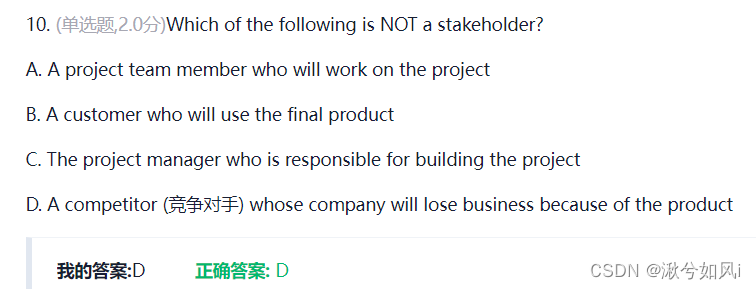
(8) 组织结构(Organizational Structure):
同后面人力资源管理部分
(9) Software Project Management定义:
Software Project Management is a system management method based on software project, which uses the relevant knowledge, techniques and tools for planning, organizing, advising and controlling each stage of software project cycle to achieve the project objectives.
(10) 软件开发生命周期(Software Development Life Cycle):
- Requirements Analysis
- Architecture Design
- Detailed Design
- Code and TestI
- Integration
- Qualification Testing
- Installation
- Acceptance Support
(11) 4种模型:
- Predictive Life Cycles
◼ Waterfall model - Incremental Life Cycles
- Iterative Life Cycles
- Adaptive Life Cycles
◼ Agile model
二、Integration Management
(1) 区分软件过程资产(Organizational Process Assets)和企业环境因素(Enterprise Environmental Factors):
Enterprise Environmental Factors are not under the control of the project team
Organizational Process Assets are the plans, processes, policies, procedures, and knowledge bases specific to and used by the performing organization.
(2) 记住以下流程的输入和输出:
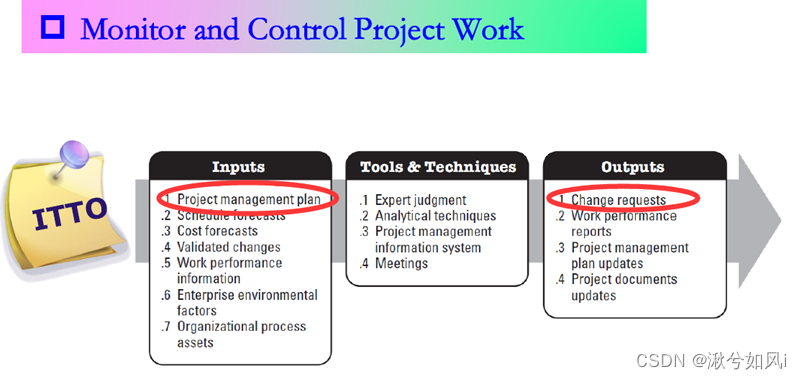

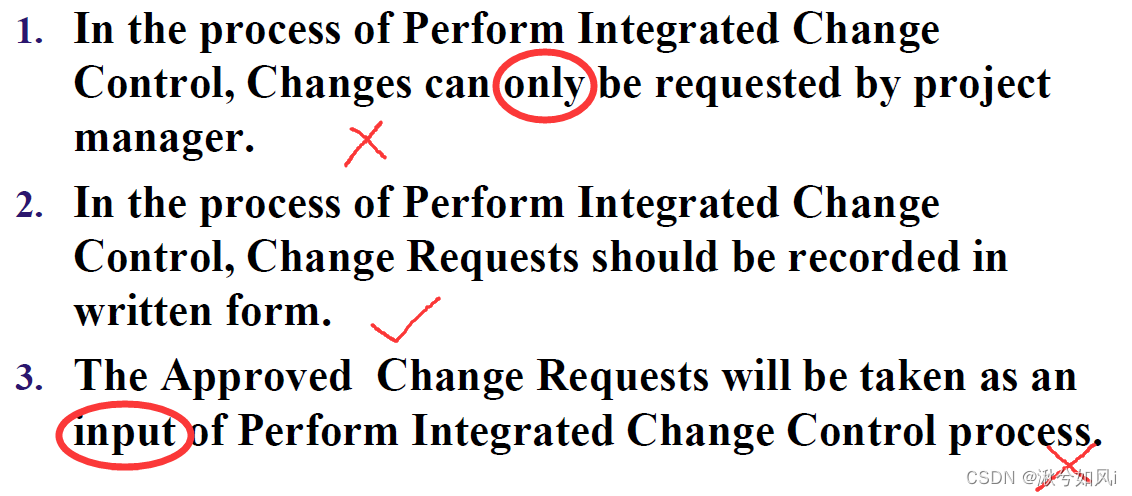
三、Scope Management
(1) 收集需求(Collect Requirements):
Brainstorming: free-thinking, no criticism, no obstruction(不能打断别人)
Affinity diagram:用来将许多ideas分类
Delphi technique:用来获取专家意见
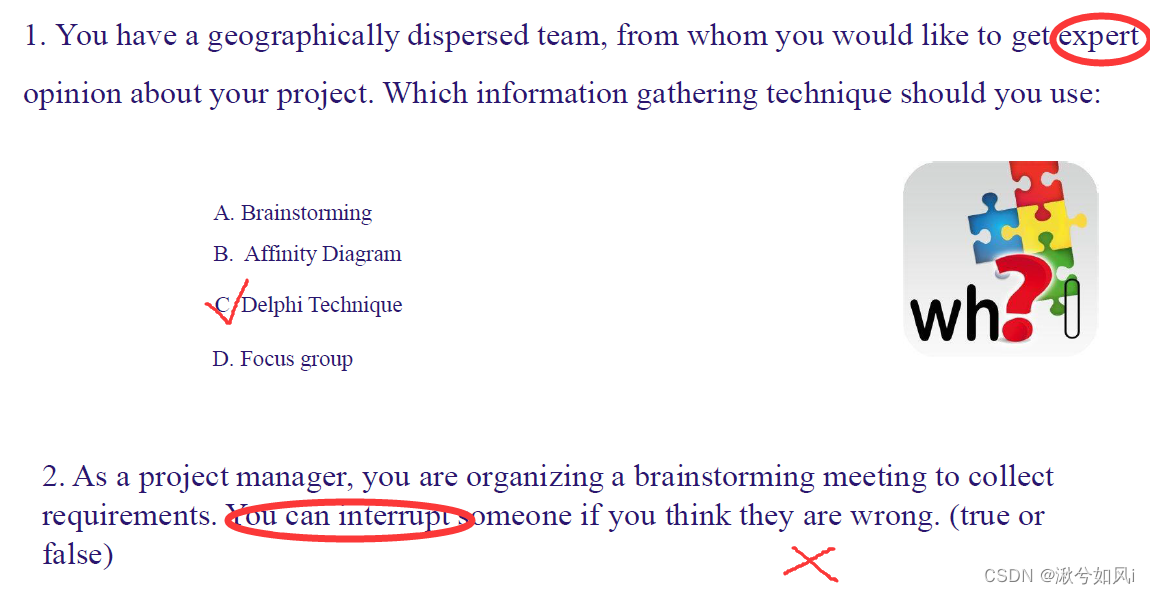
(2) Scope Baseline:
-
Project scope statement
-
WBS: WBS is a hierarchical decomposition of the total scope of work to be carried out by the project team to accomplish the project objectives and create the required deliverables.
Work Package: The work package is the work defined at the lowest level of the WBS for which cost and duration can be estimated and managed.
-
WBS dictionary(不考)
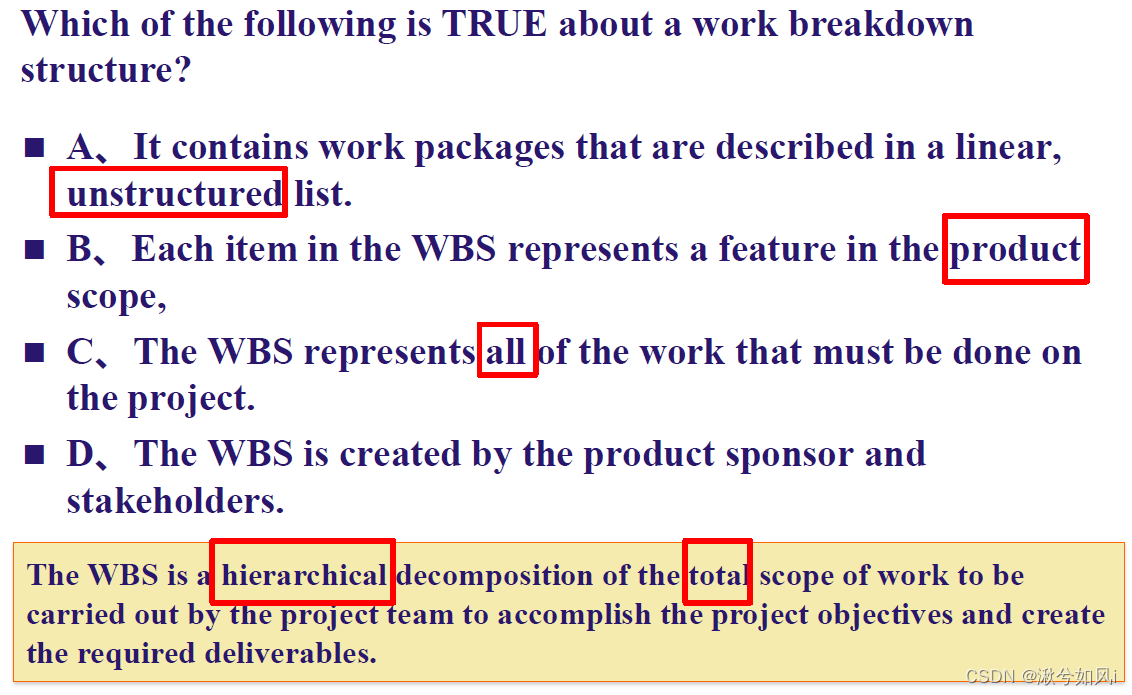
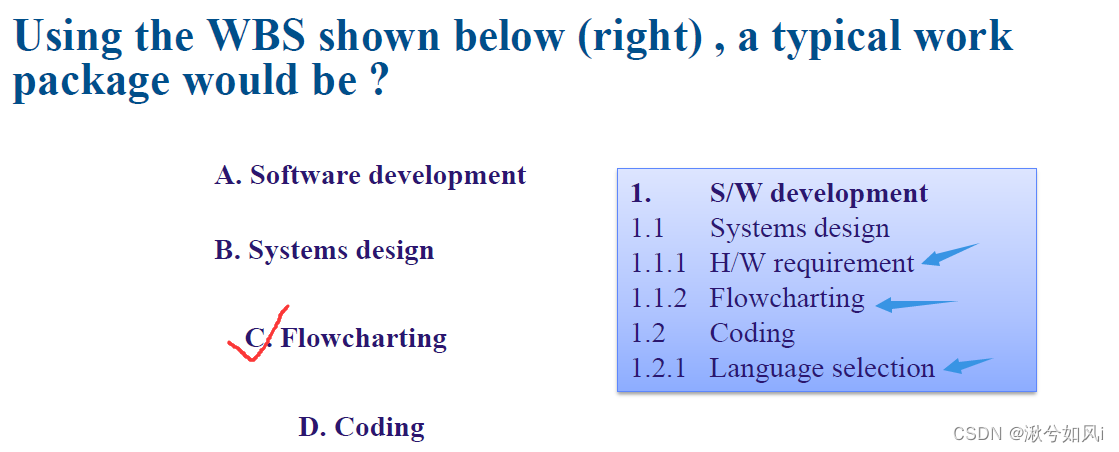
(3) 区分scope creep和gold plating:
Scope creep: The uncontrolled expansion to product or project scope without adjustments to time, cost, and resources. is given by customer 甲方爸爸无情压榨
Gold planting: is the act of giving the customer more than what he originally asked for. is done by team members actively 锦上添花卷就完了

四、Time Management
(1) 活动(Activity)的定义:
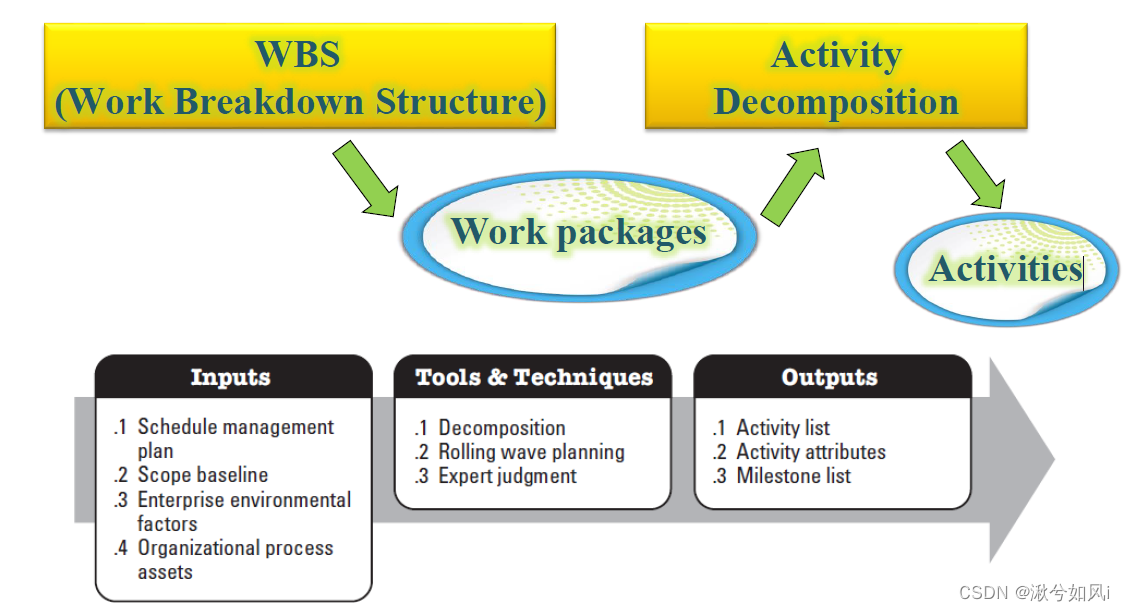
活动是由Work Package分出来的
(2) Precedence diagramming method (PDM):
- Finish-to-start (FS):颁奖仪式必须在比赛结束后
- Finish-to-finish (FF):文档写完后文档编辑才能完成
- Start-to-start (SS):
- Start-to-finish (SF):安保的第一班岗只有在第二班岗上位之后才算结束
(3) Dependency determination:
- Mandatory:强制逻辑
- Discretionary:自由决定(软逻辑)
- External:项目团队无法控制
- Internal:项目团队可以控制
(4) Estimate activity duration:
- Analogous estimating:根据历史数据
- Parametric estimating:
Duration time= quantity of work × labor hours per unit of work - Three-point estimating:
Triangle:加起来除以3
Beta(默认方法):实际占4份,最优最坏占1份,加起来除以6
(5) 关键路径(Critical Path)计算:
1. Critical path:最长的路径
2. 算Float:(一般先把所有路径的长度求出来)
- 关键路径上的活动的float都为0,直接标上
- 再把第二长的路径找出来,计算没有标过的活动的Float = 关键路径长-此路径长
- 重复第二步,每次只计算之前没有计算过的活动
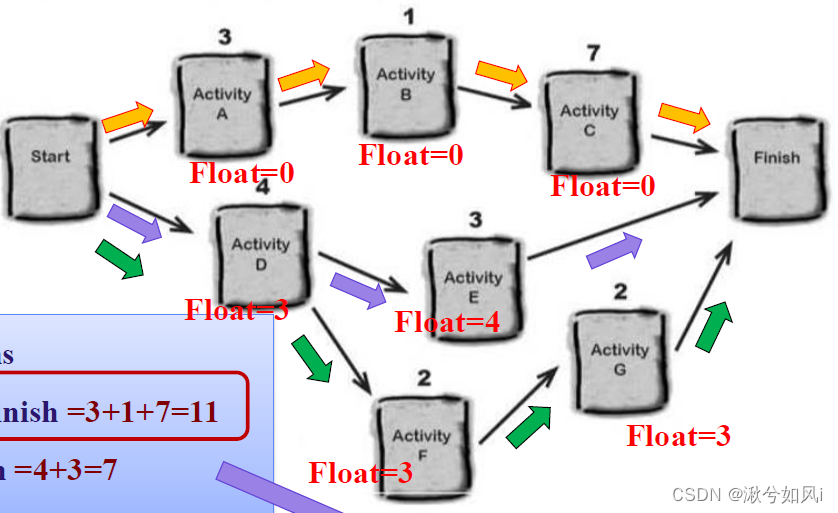
3. 算ES和EF:
- 沿着一条路径上的活动,从开始向结束计算。Start的ES和EF都是0
公式为:
ES = EF(前驱活动)+ 1
EF = ES + Duration – 1 - 如果遇到一个活动有两个前驱,取最大的继续计算
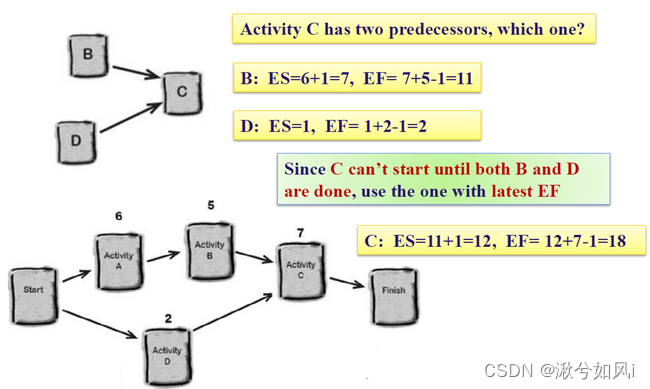
4. 计算LS和LF:
- 沿着一条路径,从结束向开始计算(逆序)。Finish的LF等于关键路径长度(应该)
公式为:
LF = LS(后继活动)- 1
LS = LF – Duration + 1
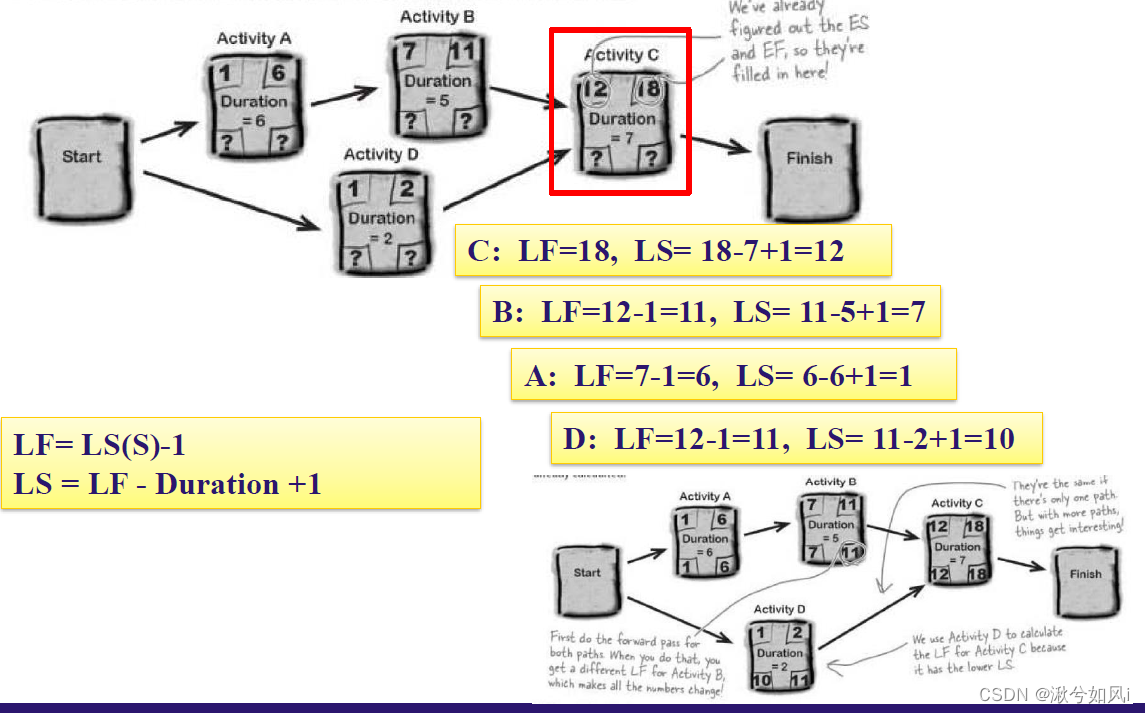
- !!简便算法!! 利用公式:

那么只需要先算出容易计算的ES和EF,分别减float即可求出LS和LF
(6) 区分Fast tracking和Crashing:
Fast tracking:同时进行多个工作来缩短工期 (风险变高)
Crashing:使用额外资源来缩短工期 (成本 变高)
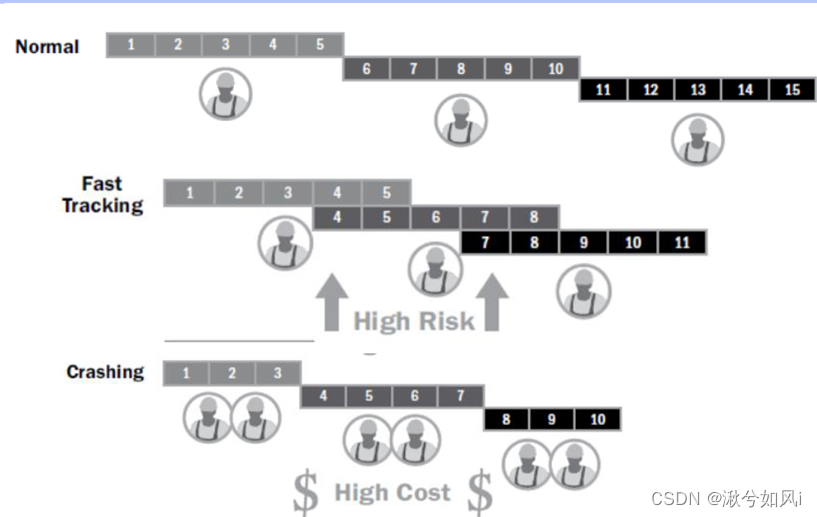
五、Time Management
(1)Function Point (FP)计算:
FP = UFC × TCF
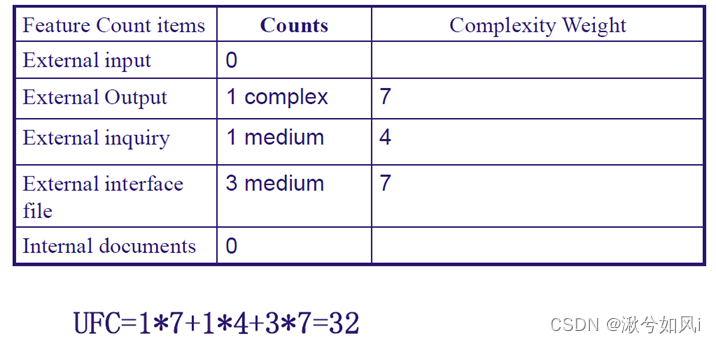

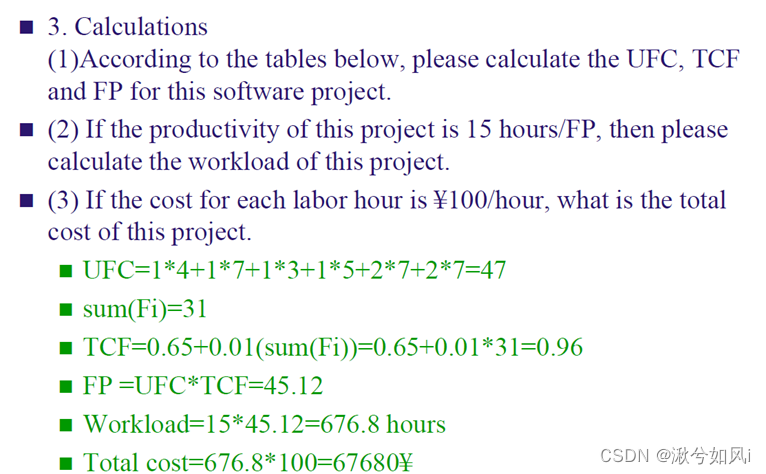
(2) 专家评估(Expert Estimation)(需要平均值):

(3) Determine Budget:
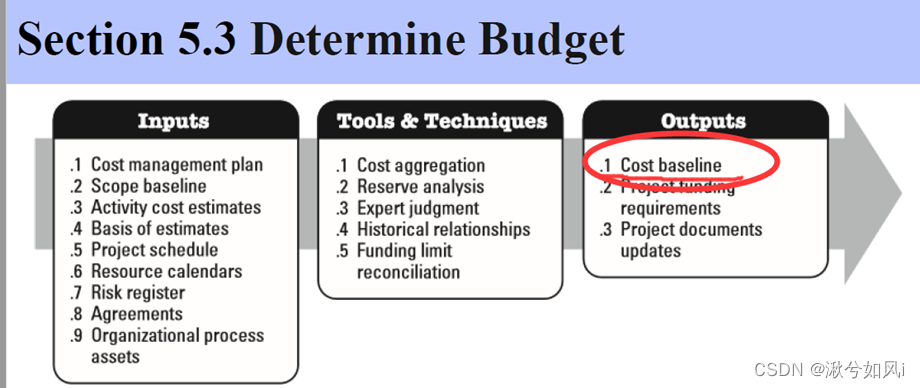
(4) EVM计算 (必考大题):
大题计算流程:
- 先写出BAC(Budget at completion项目总预算)
- PV = BAC × planned% (按计划应该完成的比例)
- EV = BAC × actual% (实际完成的比例)
- AC = 当前实际花费
- SV = EV – PV (当前完成度应该的花费 – 预计花费, 小于0说明项目进度比预计慢了)
- CV = EV – AC (即当前完成度应该的花费 – 实际花费,如果小于0说明超出预算,完成当前进度的花费比预算多)
- SPI = EV ÷ PV (其实和SV一个道理,只不过是除法,小于1说明工作量少了,低于计划了。大于1说明工作量大于计划值。)
- CPI = EV ÷ AC (其实和CV一个道理,只不过是除法,小于1说明超支)
- EAC的计算分为三种情况(只需记前两种?)
- EAC forecast for ETC work performed at the budgeted rate
EAC = AC + (BAC – EV) - EAC forecast for ETC work performed at the present CPI
EAC = BAC/CPI - EAC forecast for ETC work considering both SPI and CPI factors
EAC = AC + [(BAC-EV)/(CPI×SPI)]
- EAC forecast for ETC work performed at the budgeted rate
- VAC = BAC – EAC (一般用来抉择9,VAC小的说明预算小)
- ETC = EAC - AC (完工尚需估算 = 完工估算 - 实际花费)

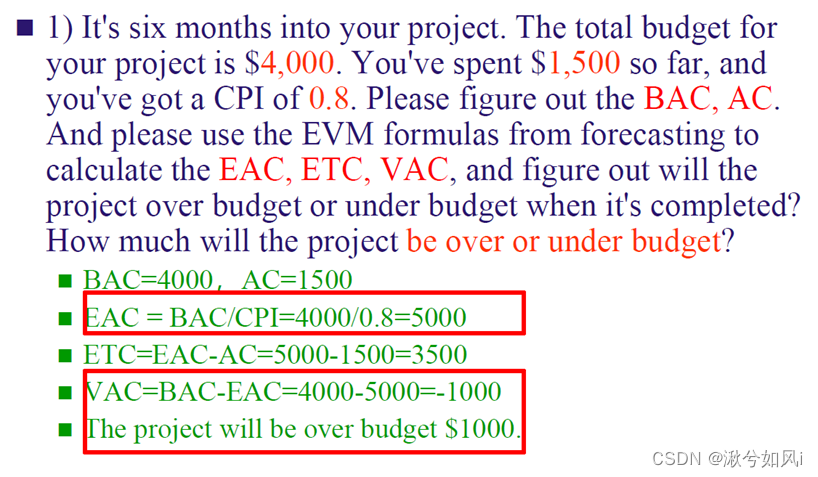
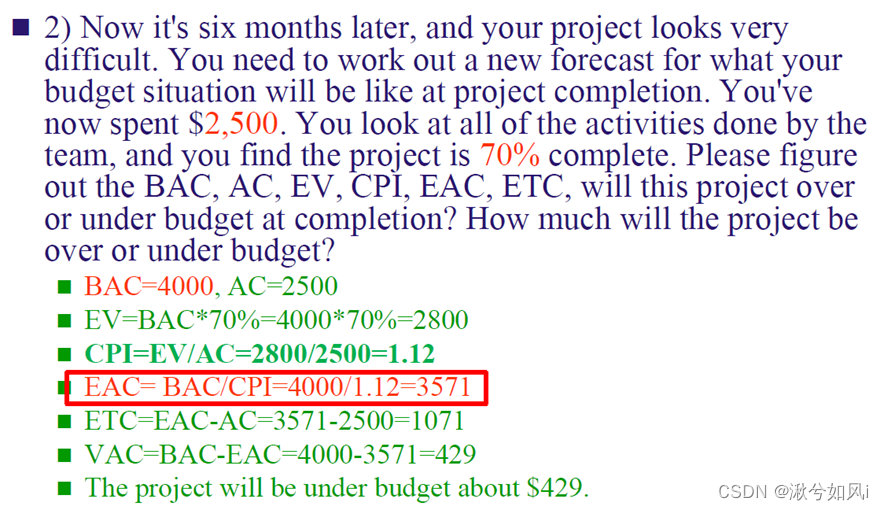
六、Quality Management
(1) 七种质量工具
- 鱼骨图(Cause-and-effect diagrams)追踪问题根源
- Flowchart
- Checksheet: gathering data to identify defects
- Histogram
- Pareto diagram:**识别造成主要问题的小部分资源 Pareto 80/20 rule
- Control chart:判断一个过程 (process)是否稳定
一个过程不稳定的判断标准:- 数据点控制极限,超过最高值或低于最低值
- 有7个连续的数据点超过均值 (Rule of seven)
- 有7个连续的数据点低于均值 (Rule of seven)
- Scatter diagrams (散点图)
(2) 质量成本图:
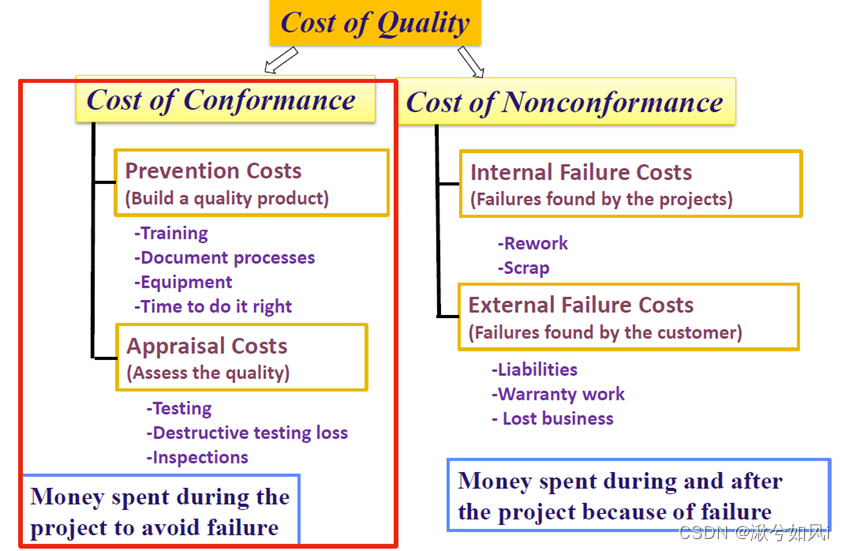
- 预防:保证项目质量的花费,如训练员工、仪器设备、文档等
- 评价:测试项目、检查项目的花费
- 内部:由项目内部引起的问题,如代码需要重写、弃置等
- 外部:由客户发现的问题
属于COQ的:PAF(Prevention/Appraisal/Failure)

(3) 区分Control Quality和Quality Assurance:
Control Quality:During the project executing and closing phases to formally demonstrate, with reliable data, that the sponsor and/or customer’s acceptance criteria have been met.
Quality Assurance:During the project’s planning and executing phases to provide confidence that the stakeholder’s requirements will be met
Control Quality means inspecting for defects in deliverables, while Perform Quality Assurance means auditing a project to check the overall process
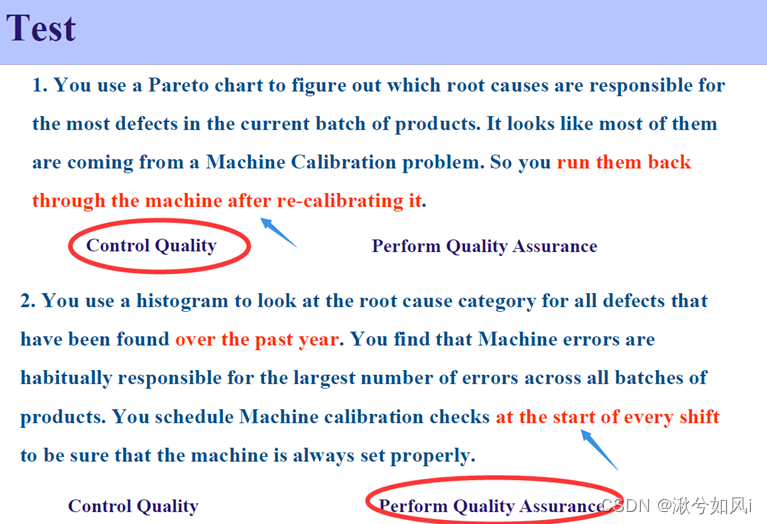
七、Human Resource Management
(1) 组织结构(Organizational Structure):
- Functional organizational structure (Functional Manager牛的)
- Projectized organizational structure (Project Manager牛的)
- Matrix organizational structure(分为三种,弱、平衡、中,个人理解按照项目经理的权利从小到大排序,弱矩阵中项目预算由功能性经理决定,强矩阵中由项目经理决定)


(2) Tuckman ladder:
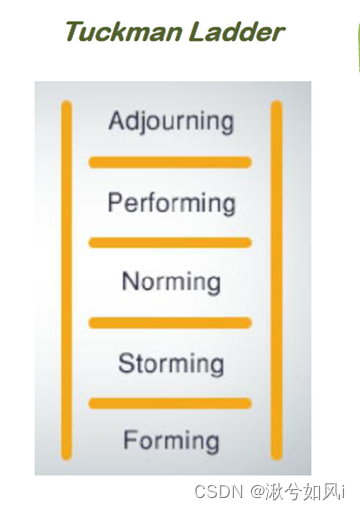
- Forming:团队成员独立对项目进行预备工作,了解自己的职责
- Storming:团队一起解决和决定一些问题 (但此时团队成员互相还不信任,合作程度不够)
- Norming:团队成员调整个人行为习惯来适应团队进行合作 (此时团队成员以及互相信任、齐心协力)
- Performing:团队成员已经能很好地合作,经常交流
- Adjourning:团队以及完成了项目,合作愉快且成功,各忙各的去了
(3) 冲突管理(Conflict Management):
- Withdraw/Avoid: 俩人都在气头上,先不吵了,存档好吧
- Smooth/Accommodate: 强调合作而不是区别,和稀泥(哦,也没什么大不了!)
- Compromise/Reconcile: 两个人都退一步,都各自放弃一部分观点
- Force/Direct: 强制采纳其中一人的观点,例如我是老板我说的算,你闭嘴
- Collaborate/Problem Solve: 互相在各自角度思考,全面分析,从根本上解决冲突和矛盾,最优的解决方案!
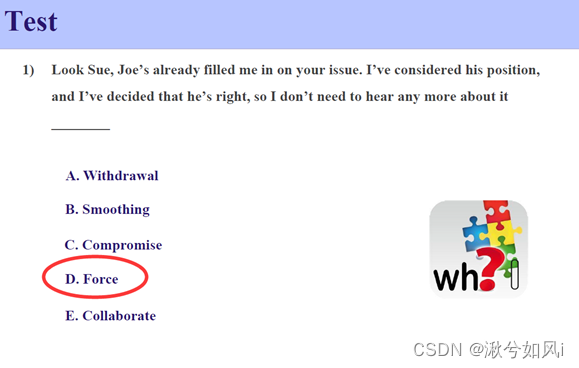
(4) RACI:
- R:Responsible
- A:Accountable
- C:Consulted
- I:Informed
八、Risk Management
(1) EMV计算:
Risk可能正面可能负面,可能会带来正收益**
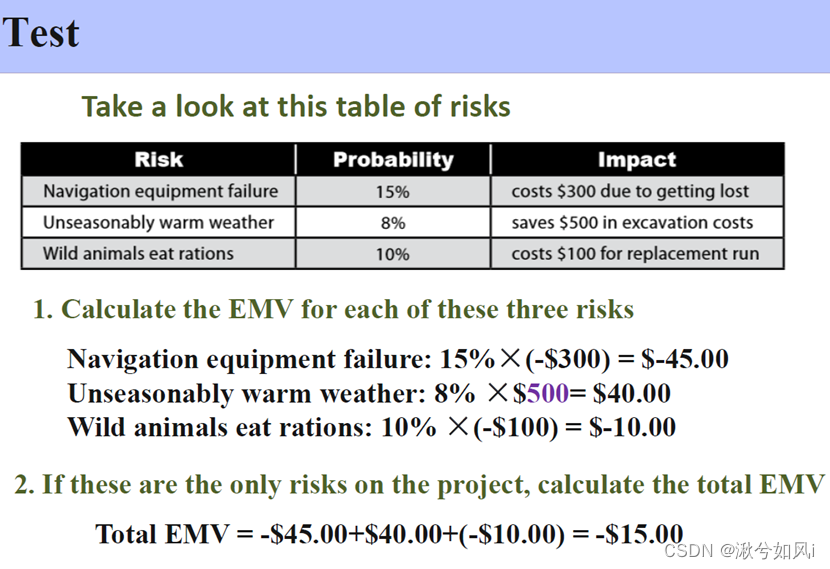
(2) Strategies for Risks:
- 对于负面风险:Avoid, Mitigate (想办法减轻风险), Transfer (花钱寻找第三方转移风险), Accept (只能接受咯,想好后续解决方案),
- 对于正面风险:Exploit, Enhance (使此风险发生的几率更大), Share (将风险分享给其他人以最大化利益), Accept (接受咯)
九、Procurement Management
似乎不考
十、Stakeholder Management
(1) 沟通路径计算(Conflict Management):
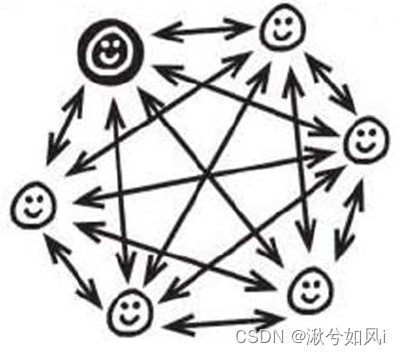
同 求无向完全图的边数 一样,每个人看做一个顶点。公式为 n(n-1)/2
但要看好有几个人,例如下面例题,题目中说You are managing a project,所以你也是项目其中的一个人,天坑!
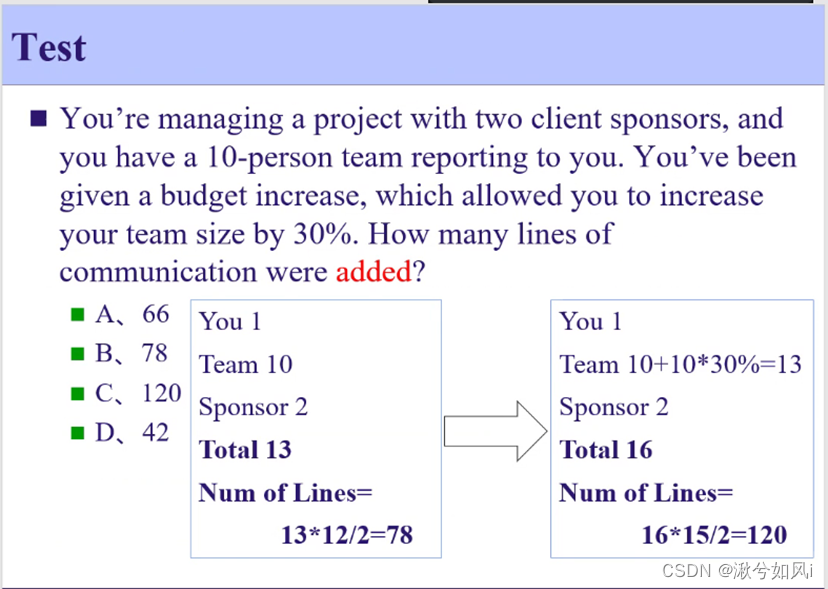
总结
某个事件发生在哪个阶段?
- Initiating:Develop Project Charter
- Planning:Develop Project Management Plan等所有带Plan的事件
- Executing:Direct and Manage Project Work, Perform Quality Assurance, Manage Communications, Manage Stakeholder engagement (带Manage的事件), 还包括和Change有关的事件
- Monitoring & Controlling:所有带Control的事件
- Closing:Close Project or Phase


祝大家考试顺利!






















 1630
1630











 被折叠的 条评论
为什么被折叠?
被折叠的 条评论
为什么被折叠?










